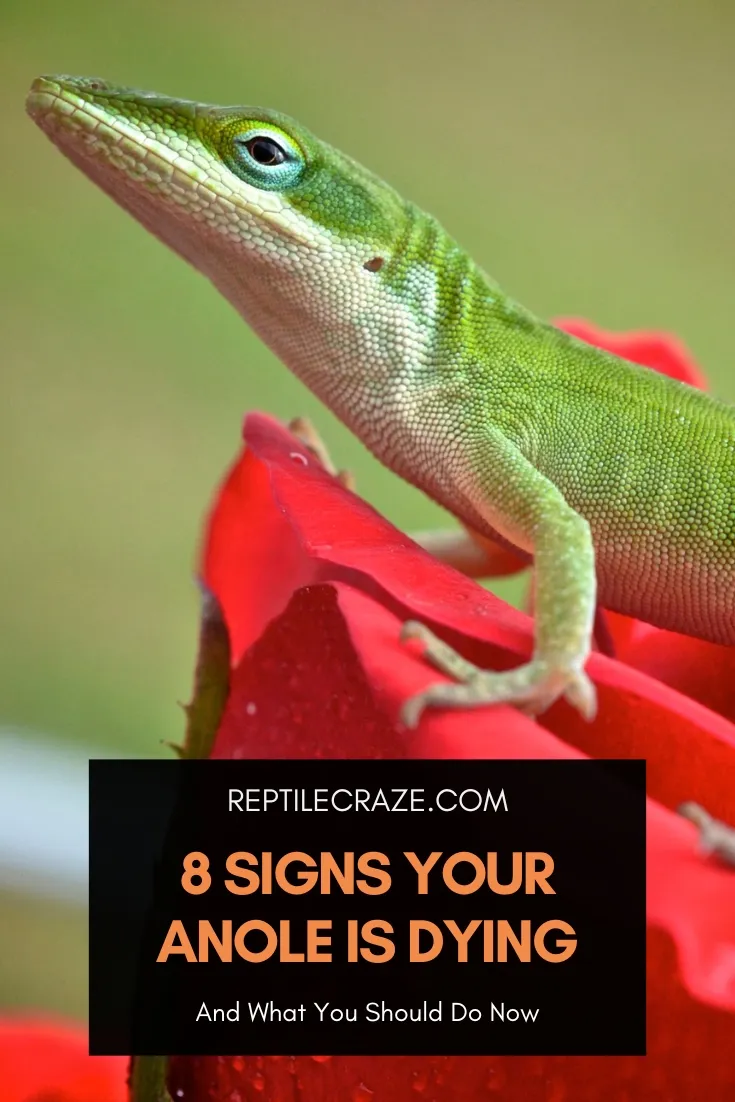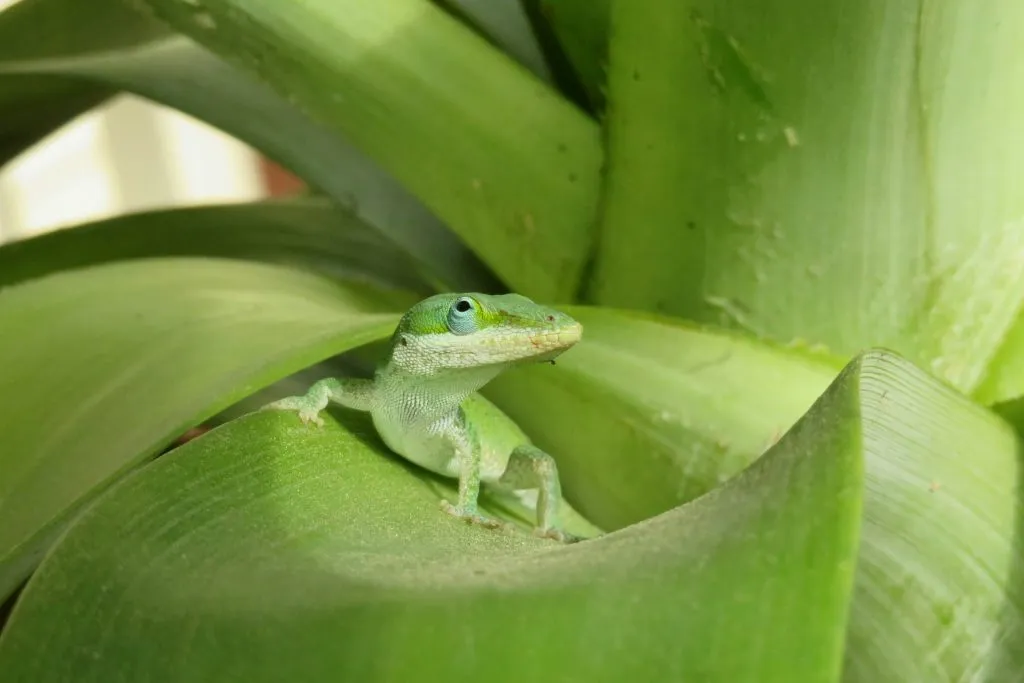
Anoles are hardy little lizards and with proper care, they can live a long and happy life while in captivity. However, many factors could cause your pet to die prematurely. So, if you notice something is wrong with your pet, and as the hours or days go by the situation does not get better, you may start to wonder whether your anole could be dying.
Signs of an anole dying may include lack of energy, refusal to eat or drink, weight loss, decrease or lack of bowel movements, discolored skin, breathing problems, behavioral changes, and/or physical abnormalities.
Nobody wants to think about the possibility of their pet dying someday. But, sadly, death is a part of life. In this article, we will tell you all about the signs that can warn you that the time for your anole’s death is close. So, keep reading to know how can you keep it from happening or help your pet pass peacefully.
Table of Contents
Signs That Your Anole Is Dying
Due to their hardiness and inexpensive price, anoles are a favorite among beginner reptile owners.
Unfortunately, this also means that they do not always receive adequate care and attention, which in most cases results in the premature death of the lizard.
With proper care, anoles can live an average of 5 years while in captivity.
Let’s take a more in-depth look into the signs that can tell that your pet anole is close to dying:
1. Lack Of Appetite
Under normal conditions, baby anoles should eat twice per day, while juveniles can eat once per day, and adults can get by eating every couple of days.
If your anole is not eating, it won’t starve right away. These reptiles can live up to two to six weeks without
However, losing all interest in
2. Lack Of Energy
Anoles are very active, alert, and fast reptiles. Depending on the specific species, some of them can also enjoy climbing on a variety of surfaces like rocks or branches.
So, if your anole is moving less than usual, is refusing to walk altogether, or is spending more time in hiding, then you need to worry. Lack of energy is a common sign of illness in these reptiles.
3. Weight Loss

Noticing subtle weight changes in anoles may be difficult for inexperienced reptile owners. In most cases, when the weight loss becomes evident, it is already too late for the anole.
Weight loss can first be noted on the reptile’s tail because that is the place where most fat deposits are stored.
When the animal continues losing weight, you can notice its face and head starts to become bony and its rib cage starts to show.
Weight loss can either mean your pet is not being properly fed, or that it has an underlying health condition that is causing it to slowly waste away.
4. Not Pooping
Normal depositions of anoles are comprised of two parts, a dark brown log-shaped piece, which is the stool per se, and a white pointy piece, which is the urate (urine).
You need to familiarize yourself with your anole’s poop schedule in order to notice any irregularity early on.
A decrease or lack of bowel movements might mean that your pet is eating less or that it is constipated or impacted, both of which are serious and potentially life-threatening conditions.
5. Dehydration
Anoles thrive in humid environments, and prolonged dehydration can be life-threatening for these reptiles.
Signs of dehydration in anoles may include:
- Sunken eyes
- Rough and wrinkly skin
- Retained shedding
- Loose skin
- Sticky saliva
- Lack of energy
There are several reasons why your pet may become dehydrated, including low humidity levels or too high temperatures in the enclosure and not providing them with proper water sources. Gastrointestinal illnesses such as ulcers or diarrhea may also lead to dehydration in your anole.
6. Breathing Difficulties

Respiratory infections are common in anoles. You should suspect this if your pet is having trouble breathing, is wheezing, or has mucus around its mouth and/or nose.
7. Discolored Skin
The color and pattern of each anole species will vary depending on its natural habitat and climate; however, most anoles will display a change in color as a response to environmental factors, stress, or disease.
8. Behavioral Or Physical Abnormalities
Your anole may suddenly start having tremors, abnormal body postures, or walking difficulties such as tilting sideways or loss of balance. Any of these changes may be the result of inadequate husbandry settings, underlying illness, or an injury.
Unfortunately, anoles are fragile pets when it comes to handling them, and just a little bit of pressure or a fall from a short distance can harm them and cause them to get fractures and/or life-threatening internal injuries.
What To Do If You Believe Your Anole Is Dying
You need to try to find and correct all the possible reasons that may be leading your anole to deteriorate.
If you have more than one anole in the enclosure, keep the sick anole isolated from the rest to help prevent any underlying disease or infection from spreading.
As long as the cause of your anole being sick is not a serious disease, injury, or infection, treating your pet at home may be possible as a first step before taking it to the vet.
Keep in mind that as anoles get older, they may die from natural causes, so you won’t be able to prevent them from dying if this is the case. However, you can make sure they are as happy and comfortable as they can be during their last few days.
Let’s see what things you can do to help your anole get better or at least die peacefully:
Make Sure The Environment Is On Point
Since stress is one of the most common reasons for anoles to start wasting away, you should ensure to provide your pet with adequate environmental conditions:
Temperature

In the wild, anoles live in an extensive variety of climates and habitats, which makes them hardy reptiles able to tolerate a wide range of temperatures. However, setting up a proper temperature gradient is always necessary when keeping them in captivity.
A temperature gradient means you should have a cooler side and a warmer side in the enclosure, which will allow the anole to go from one spot to the other to self-regulate its body temperature.
During the day, the ambient temperature should range from 75 to 80 °F (23 to 26 °C); while, at night, it should be kept between 65 and 75 °F (18 and 23 °C).
A basking area set up in the warmer spot of the enclosure is necessary for your anole to be able to heat up quickly, the temperature should reach 85 to 90 °F (29 to 32 °C) in this spot, only during the day.
If the temperature in the enclosure is too high, your anole may overheat and get dehydrated. On the other hand, if the temperature is too low, your anole may become lethargic and won’t be able to move as usual.
Lighting
You need to provide appropriate light sources for your pet.
Besides the basking light, anoles need UVB-emitting lights for at least 12 hours during the day to be able to synthesize vitamin D3, which will prevent them from getting a serious disease called metabolic bone disease (MBD).
Humidity
Anoles thrive in humid climates. The humidity levels in the enclosure should be maintained around 60% to 70%.
To achieve this, you need to mist the enclosure a couple of times per day. You can also set up an automatic dripper or mister system.
Misting will also provide enough water droplets for your pet to drink.
A hygrometer is ideal to monitor that the humidity levels stay at an appropriate range for your pet.
Lower humidity can cause your pet to become dehydrated, while high humidity can be the cause of respiratory illness.
Substrate
Substrates like sand and gravel are not recommended since your anole may accidentally ingest them while feeding itself, which will result in constipation or impaction (partial or complete blockage of the gastrointestinal tract).
Instead, you can use commercial reptile-safe soils or bedding, peat moss, and bark, such as orchid bark.
Provide An Adequate Enclosure
Although anoles are small lizards, they need a lot of space to move around. A small enclosure may stress the anole and lead to illness.
A 10-gallon tank is adequate for single anoles, while a 20-gallon tank should fit two or even three anoles. When it comes to the size of the enclosure, the bigger the better.
The enclosure should be kept clean, and all fecal waste and uneaten
Do Not Place Two Males Together

Anoles can be housed together as long as you do it properly. A male and female can be put together, as well as one male and up to four females.
However, never put two or more males together as they will inevitably fight for the territory and will bully the weaker anole into submission, going as far as establishing dominance over the basking spot and taking away all
The weaker anole is going to end up getting sick from all the stress and lack of food.
Make Water Sources Available
Even though anoles rarely drink from standing water, placing a shallow chlorine-free water dish in the enclosure may help to keep up the ambient humidity levels. Just make sure to clean the dish and replace the water every day.
After misting the enclosure, make sure there are enough water droplets on the leaves of the plants and surfaces of the enclosure so your anole can lap them off.
If you notice dehydration signs in your anole, you can give it a long misting session. If you think that won’t suffice to rehydrate it, then you can try soaking it in lukewarm water.
Feed Your Anole A Balanced Diet
Anoles are mainly insectivorous, meaning that they feed on insects. Crickets, roaches, moths, waxworms, and mealworms are some of the suitable insects you can feed to your pet.
Make sure the insects are no larger than half the size of the head of your anole and place them in the enclosure where your pet can easily see them to encourage its hunting instincts.
You should also regularly dust the feeder insects with a calcium and vitamin D3 supplement, as well as gut-loading them before giving them to your pet.
This means that you need to feed the insects with a lot of vitamin-rich fruits and vegetables for at least two days before offering them to your anole. That way, you will ensure your pet gets maximum nutrition.
The other thing you need to be mindful of is to not give your pet wild-caught insects, as these can be full of parasites and/or pesticides that will make your anole sick and may even kill it.

Always get your insects from a trusted source.
Besides eating insects, anoles may also eat fruit, some flowers, and even fruit-flavored baby
When To Take Your Anole To The Vet
If your anole sustained an injury or fall, and then you start noticing any of the signs mentioned above, or if you can see a lump on its tail, legs, or body, then take your pet to the reptile vet as soon as possible.
You should also visit a vet in cases where your pet did not sustain a fall or injury and just started showing any of the signs mentioned above.
Or if you have ruled out any possible cause for stress or sickness but you are still seeing no improvements in a couple of days or if your pet’s condition is getting worse.
- Enchi Ball Python: A Unique and Stunning Morph of Python regius - March 27, 2025
- Emerald Tree Monitor: The Enigmatic Green Guardian of the Rainforest - March 26, 2025
- The Egyptian Cobra (Naja haje): A Fascinating Serpent - March 25, 2025
